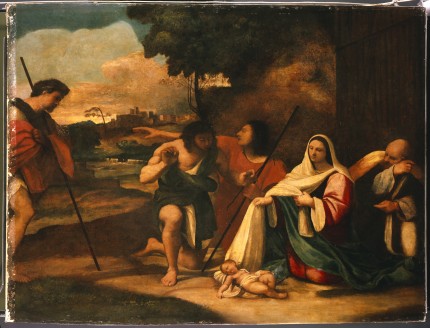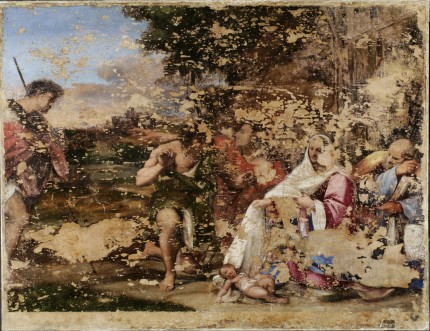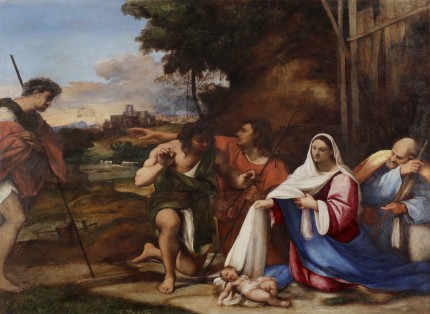The University of Cambridge’s Fitzwilliam Museum has restored a 16th century painting by Sebastiano del Piombo that has been in dire condition for centuries. The restoration took a full decade of research and painstaking work by conservators at the museum’s Hamilton Kerr Institute to complete.
Sebastiano Luciani (he got the “del Piombo” moniker after his appointment to the Papal office of the leaden seal in 1531) was born in Venice around 1485. He started off his career in the arts as a lute player and while he was successful at a young age and very much in demand by the nobles of Venice, he soon changed course to painting, becoming a student first of Giovanni Bellini, who was by then in his 70s, and then of Giorgione a former pupil of Bellini’s who while still in his 20s had already made a name for himself and won several important commissions. Giorgione had a strong influence on the young Sebastiano, and indeed more than one of his early works were believed for centuries to be pieces by Giorgione.
In around 1511, Sebastiano moved to Rome at the behest of the powerful Sienese banker Agostino Chigi. There he met Michelangelo who had just revealed the first part of his epic fresco on the ceiling of the Sistine Chapel when Sebastiano arrived. Sebastiano was a congenial, charming fellow, enough to get along with Michelangelo who was notoriously prickly. According to Giorgio Vasari, Michelangelo appreciated the young artist’s color skills and the gracefulness of his work and decided to take him under his wing.
 Shortly after he arrived in Rome, Sebastiano painted the Adoration of the Shepherds for an unknown patron. The influence of Giorgione and the Venetian school is seen in the color palette and in the landscape of the painting (see for example Giorgione’s Adoration of the Shepherds painted around the same time that is now in the National Gallery of Art in Washington, D.C.), while the dynamic, animated figures show the influence of Michelangelo.
Shortly after he arrived in Rome, Sebastiano painted the Adoration of the Shepherds for an unknown patron. The influence of Giorgione and the Venetian school is seen in the color palette and in the landscape of the painting (see for example Giorgione’s Adoration of the Shepherds painted around the same time that is now in the National Gallery of Art in Washington, D.C.), while the dynamic, animated figures show the influence of Michelangelo.
The painting first appears on the historical record in 1724 as part of the collection of the Duke of Orléans. It was attributed to Giorgione at that time, and still was in 1800 when museum founder Viscount Richard Fitzwilliam bought it at the sale of the Duke of Orléans’ collection in London after the French Revolution. The painting was part of the original bequest to his alma mater the University of Cambridge that created the Fitzwilliam Museum in 1816. It was only in 1913 that scholars attributed the Adoration of the Shepherds to Sebastiano del Piombo based on the fusion of Venetian and Roman elements that was characteristic of the artist’s work.
The painting has been in storage for 70 years because it was considered undisplayable in its condition. It was marred by thick layers of overpainting and X-rays and infrared imaging had shown that the original paint underneath was severely damaged. There was much discussion about whether conservation should even be attempted on so precarious a piece. Ten years ago, conservators at the Hamilton Kerr Institute began to seriously investigate the possibility of restoring the work. Sebastiano was a very slow painter and once he got the leaden seal job he was even slower. Most of his surviving works are portraits. A large religious piece by him is a rarity. Ultimately conservators decided that the overpainting was so atrocious, so far from the original in color and design, and enough of the critical areas of the original survived that it was worth tackling, even though it would require filling in significant areas of paint loss.
Here’s what it looked like before cleaning:

When the layers of overpaint and yellowed varnish were removed, conservators could see right away that the damage to the painting was not the result of the mere passage of time. It was caused by a botched transfer from original wood panel to canvas, probably when the Adoration was in the collection of the Duke of Orleans. Such transfers were considered a valid conservation approach at that time, particularly in the France, but they were hugely risky. On smaller works the painted surface was shaved off and applied to canvas. On larger pieces, a fabric facing was glued to the surface then either the wood was removed by carving or a corrosive until all that was left was the paint stuck to the facing. Canvas was then glued to the back and the facing carefully removed. Sometimes it worked and the painted surface adhered to the canvas. Sometimes it went horribly wrong and a precipitous amount of paint was lost.
Here’s what it looked like after the overpaint and varnish were removed:

Since the owner wanted his Old Master back on the wall, the damage was obscured by repainting. When that began to fail it was repainted again, lather, rinse, repeat. The botched transfer took place around 1750. Before the tragic events, a copy of the painting when it was still on panel was made. That copy is now in the Louvre. Without this copy, conservators would likely never have attempted this restoration because filling in the missing paint would have required too much guess work to be decently accurate. Thankfully, the original paint that survived the transfer proved resilient, tough enough to withstand the removal of multiple layers of overpainting.
In order to understand the artist’s technique, a microscopic particle of paint, smaller than the head of a pin, was taken from the Virgin’s blue robe and analysed under a microscope during research. Examination of the paint cross-section demonstrated Sebastiano’s sophisticated system of layering with an application of pink paint beneath the blue, as well as his use of superior and expensive pigments, such as ultramarine blue. This and other forms of state-of-the-art analysis greatly helped to reconstruct the missing areas. […]
[Director of the Hamilton Kerr Institute] Rupert Featherstone added, “We have conserved over 3,000 pictures in the last forty years at the HKI, but the Sebastiano is one of our biggest projects. Some might have argued to leave the painting as an archaeological relic, but I think we have made the right judgement to restore it so it can be appreciated as the masterpiece it is, aesthetically and historically. The scientific research that was conducted to aid our understanding of the technique of the artist has been key in being able to recreate it.”
Here’s what it looks like now:

The restored Adoration of the Shepherds is the Fitzwilliam’s “Object of the Month” for June and is now on display in the museum’s Flower Gallery.